Ricochet is the best place on the internet to discuss the issues of the day, either through commenting on posts or writing your own for our active and dynamic community in a fully moderated environment. In addition, the Ricochet Audio Network offers over 50 original podcasts with new episodes released every day.
 Share Your Expertise: Some Things You Should Know About Orbital Mechanics
Share Your Expertise: Some Things You Should Know About Orbital Mechanics
The Ricochet staff solicited our expertise. Your friendly neighborhood aerospace engineer is here to deliver it from my desk on the corner of Karman Vortex Street and Tomcat Alley. (You may have seen my previous writing on the NAVSTAR GPS.) In this article we’ll cover a few common misconceptions about orbital mechanics and then ‘splain some fundamentals for the layman. There’s always some overlap between topics, and this article touches on reentry aerodynamics as well, but without further ado here is the orbital mechanics edition.
There is gravity in space
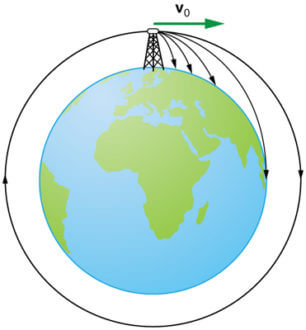
With sufficient speed a free-fall trajectory never intersects the Earth.
Some people imagine that if you just fly high enough you’ll reach space, escape Earth’s gravity, and start floating around. But at 300 miles altitude where the the International Space Station orbits, Earth’s gravity is still 90% as strong as it is on the ground. What makes the astronauts feel weightless is that they and the ISS are mutually in free-fall. It’s like they are perpetually on the downhill leg of a giant roller coaster, falling toward the ground at about 0.9 g and giving them that floaty feeling in their stomachs.
But the ISS and the astronauts inside it are also moving laterally at tremendous speed — faster than other free-falling objects like golf balls, bullets, artillery shells, and even ICBMs. Their path of free-fall is so far ahead of them it doesn’t even intersect the Earth. That’s called orbit.
So to get up in space and stay there, it’s not enough just to fly up to a high altitude outside the atmosphere. You have to achieve enough lateral speed that when you inevitably fall back toward the Earth, you miss.
Orbiting is all about speed
It takes much, much more energy (i.e. fuel) to reach orbital speed than merely to reach a space altitude. That’s why orbital rockets are so much bigger than suborbital space planes. Compare the X-15 at the left side of the figure with similarly sized X-37B at the right (the little gray vehicle inside the nose fairing at the top). The X-15 reached space altitudes but even at Mach 6 was far to slow to stay in orbit. The enormous Atlas V/Centaur rocket system is required to give the similarly-sized X-37B enough speed to stay in orbit. Almost all of that extra size is fuel.

The world’s space planes. (Credit: By Kelvin Case at English Wikipedia. CC BY-SA 2.5, https://commons.wikimedia.org/w/index.php?curid=19861947)
The speed required to stay in orbit depends on the strength of the gravity field (i.e. the mass of the planet or star you are orbiting) and the altitude of the orbit. But perhaps counter-intuitively, the required speed does not depend on the mass of the orbiting object* — a pebble and a school bus at the same altitude will orbit at the same speed. This is directly related to the principle that all objects fall at equal speeds under gravity regardless of their mass. (* However, the size of the rocket required to achieve a given speed is highly dependent on the mass of the object.)
Imagine swinging a ball on a string in a circle around you. Without any force on it the ball would naturally move in a straight line, but the tension in the string provides a centripetal force (a force “toward the center”) and the result is a circular motion. We have an equation for the unique amount of centripetal force required for circular motion at any given speed and radius. If you change the speed or the length of the string the force changes. If you let go of the string, the ball flies off in a straight line.
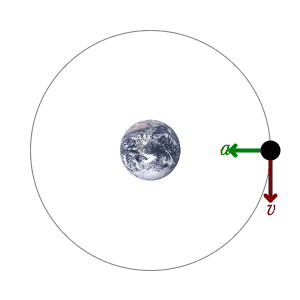
The vector “v” represents the velocity, and the vector “a” represents the centripetal acceleration due to gravity. Since the acceleration is perpendicular to the velocity, the object changes direction but not speed. Not to scale.
In the same way, gravity provides the centripetal force to keep an object in orbit. At any given altitude the force of gravity has a specific value, so there is one specific speed that results in a circular orbit at that altitude (Other speeds give different orbit shapes. More on that later.). Gravity is stronger at lower altitudes and gets weaker as you go up, so higher orbits have lower speeds. In principle you could orbit a planet at any altitude, but there is a practical lower limit because at some point atmospheric drag causes objects to slow down and fall back to Earth. There is also a practical upper limit where the gravity from other celestial objects becomes comparable in strength to the gravity from the Earth and affects the motion.
Now you might think back to the ball analogy and realize a heavier ball requires more force from the string. That’s true for orbiting objects too. But gravity by its very nature pulls harder on heavier objects precisely proportional to their mass, so it perfectly evens out.
Orbits come in many shapes and sizes
Circular orbits are easy to conceptualize and understand. But in general, orbits are not perfectly circular. Most orbits take the shape of an ellipse. Some ellipses are nearly circular, and some are so elongated (eccentric) they appear to be a long thin sliver. There are even orbits so eccentric that the ellipse never closes at the other end. More on that later.

An elliptical orbit has the gravitating body at one focus and nothing at the other. (Credit: CC BY-SA 2.0 at, https://commons.wikimedia.org/w/index.php?curid=223077)
In an elliptical orbit, the gravitating body is not at the center, but rather tucked down in one end at a focus of the ellipse (plural: foci; every ellipse has two). This is Kepler’s First Law of orbital motion. The other focus is an imaginary point symmetrically placed on the other side of the ellipse.
Although the motion is more complex than a circular orbit, it obeys the same type of relationship between speed and distance. At the near end of the ellipse, the orbital speed is very fast, and at the far end the speed is very slow. The relationship between speed and distance is mathematically complex but geometrically very simple: the orbiting object sweeps out equal areas in equal time. This is Kepler’s Second Law of orbital motion.
This video shows wedges of blue and gray which each have exactly the same area. The planet takes exactly the same amount of time to sweep across the base of each wedge.
One of the most famous examples of a highly eccentric elliptical orbit is Halley’s Comet, which takes 76 years to complete one revolution. The speed of Halley’s Comet varies by more than a factor of 60 between its closest approach to the Sun (perihelion) and its farthest reach (aphelion). At the near end to the Sun it spends about 2.5 years inside the orbit of Jupiter. At the far end, it takes over 30 years to cover the same distance. Other comets even have orbits that are much more extreme.
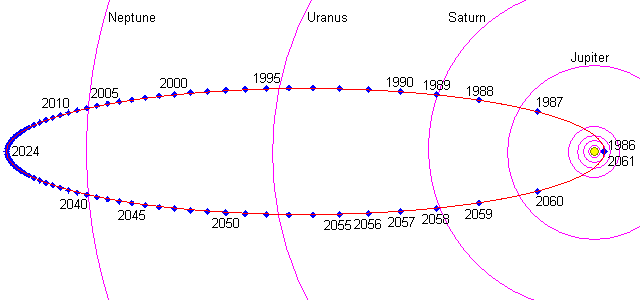
A two-dimensional view of the orbit of Halley’s Comet. Its progress is indicated by year, showing the great variation in speed throughout its course. (Credit: Steven Dutch, University of Wisconsin-Green Bay)
You don’t have to achieve escape velocity to reach orbit
Escape velocity is the speed of an orbit that will reach infinite altitude. That’s not an exaggeration – an object which has achieved escape velocity will never stop and fall back down. Given enough time it will pass any arbitrarily large altitude you can think of. The escape velocity depends only on the mass of the gravitating body and your altitude from it — it is higher for larger planets and at lower altitudes.
Any object travelling slower than escape velocity will either fall to the ground or curl around and orbit the Earth in an ellipse. An object moving faster than escape velocity is on an escape orbit, which is not an ellipse, but a hyperbola*. A hyperbolic orbit is an arc that passes near the planet but never curls back around at the other end. Instead it extends to infinity as it asymptotically approaches a straight line. The following video demonstrates the different orbit shapes very clearly. (* The rare object traveling at exactly escape velocity follows the closely-related parabola.)
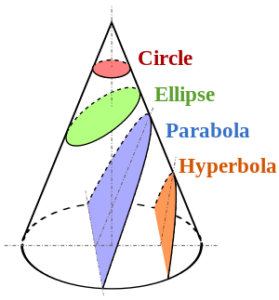
The conic sections. (Credit: By Drini (Own work) [GFDL (http://www.gnu.org/copyleft/fdl.html) or CC BY-SA 4.0-3.0-2.5-2.0-1.0 (http://creativecommons.org/licenses/by-sa/4.0-3.0-2.5-2.0-1.0)], via Wikimedia Commons)
All of these shapes are called the conic sections: the shapes you get when you slice a cone at different angles.
In a sense, an object in a hyperbolic escape orbit is traveling so fast it is outspeeding gravity’s ability to restrain it. It is slowed by gravity just like any other object, but as it speeds away from the planet gravity gets weaker. Its very high speed causes it to enter ever weaker regions of the gravity field such that there is never enough gravity to slow down and start descending. You can usually calculate the time at which an object under the force of gravity would lose all its speed and start to fall. For an object at escape velocity, that time is infinite.
Satellites launched into Earth orbit never reach escape velocity, they settle into nice circular or elliptical orbits. Spacecraft launched to the Moon or other planets, or into deep space like Voyager and New Horizons, leave the Earth above escape velocity. They will never return to Earth barring a drastic maneuver imparted by either a rocket or the gravity of some other object.
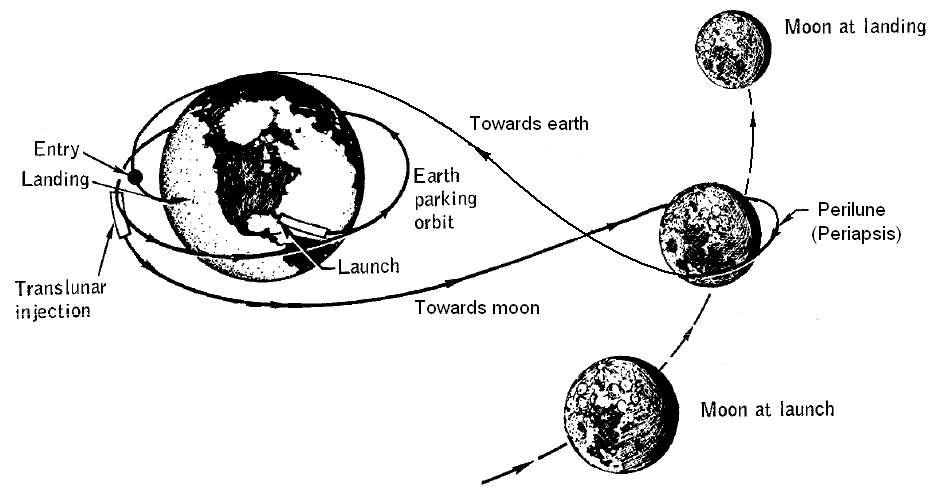
A circumlunar free-return trajectory. The translunar injection in the lower left put the Apollo capsule on an escape trajectory. Another burn was required on the return leg to slow down below escape velocity and re-enter. Not to scale.
The Apollo spacecraft returned using both of those methods. The first several Apollo missions were launched into Earth-escape orbits that happened to intersect the Moon’s orbit in a special way. They used the Moon’s gravity to interrupt the escape trajectory and turn their orbit around to create a “free-return trajectory”. However, the vehicle would now be travelling back toward Earth above escape velocity, so a rocket burn and aero-braking were required to slow down and keep from flying right past Earth and into deep space again.
Which brings up my final point about escape velocity. The weirdest thing about escape velocity is that it works in any direction, up, down, or sideways, so long as you don’t crash into the planet. That is, if you had a tunnel through the Earth with no air in it, you could launch a rocket directly downward into the tunnel at escape velocity and it would be just as effective as launching it straight up.
The Lagrange points bring balance to the cosmos
I’ve written about the Lagrange points before, but they are so great I couldn’t resist repeating it here.
So far we have only talked about orbits in the simplest possible two-body scenario, in which the body in orbit is so minuscule compared to the primary body — like a planet and a spacecraft — that the effects of the smaller body’s gravity field on the primary are negligible.
Another interesting configuration is the restricted three-body problem, which expands on the above by adding a second massive body which interacts with both the primary and the minuscule object — like a star, a planet, and a spacecraft. In general, any system of orbiting bodies has a set of Lagrange points, and a restricted three-body system has five such points labeled L1 through L5.
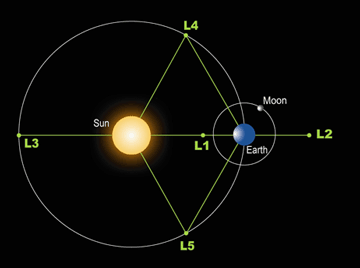
The five Lagrange points of the Earth-Sun system. Not to scale.
Using the Earth-Sun system as an example, think of our Lagrange points as balancing points where the Sun’s and Earth’s gravitational pulls combine to provide precisely the required centripetal force for a circular orbit about the Sun which passes through that point. An object placed there will not fall toward the Earth or Sun, nor will it pass ahead or behind the Earth. Its orbital angular speed around the sun will match the Earth’s even though it’s at a different orbital altitude from the sun, and it will seem to be suspended in place relative to the Sun and Earth.
The L1 point is the equilibrium point that lies about one million miles on a direct line from the Earth toward the Sun. From the Earth’s perspective, an object at L1 always remains directly in front of the Sun. L1 is a useful place to put a Sun-observing spacecraft because it will have an unobstructed view of the Sun, or an Earth-observing spacecraft because it will always see the fully illuminated daylight side of the Earth.
The L2 point is another useful place for spacecraft because it is in perpetual midnight, so light from the Sun and Earthshine never enters the field of view and it provides a dark place from which to observe the sky.

A representation of the asteroid belt (white) and the Trojan asteroids of Jupiter (green). The latter are congregated around the gravitational equilibrium points called L4 and L5 of the Jupiter-Sun system.
The L4 and L5 points are historically interesting. They are 60° ahead and behind a planet in its orbit, forming two equilateral triangles. In 1772 Pierre Lagrange was analyzing the restricted three-body problem, probably with a quill and paper, and upon calculating the combined gravitational field, he hypothesized that asteroids should have accumulated over time at equilibrium points we now call L4 and L5 of the Sun-Jupiter system (because Jupiter has by far the strongest gravity field after the Sun). But no telescopes were powerful enough at the time to see them. Finally in 1906, astronomers spotted the first of Jupiter’s “Trojan asteroids“, shown in green in the figure at right. I am not aware of a scientific experiment that had a longer time gap between hypothesis and observation.
Here’s an animation that removes the “normal” white asteroids from the image and shows only the interesting asteroid motions involving the Jupiter-Sun Lagrange points. (The magenta asteroids are another interesting class called the Hildas.)
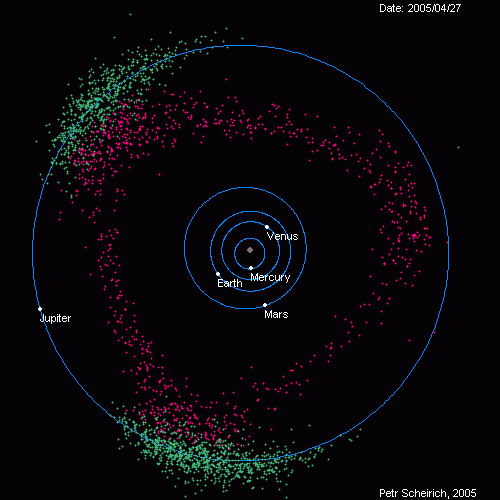
Bonus Topic: Reentering spacecraft don’t heat up because of friction
Now to bring things back down to Earth. You often hear about fast traveling objects heating up “due to friction” with the air. In fact, the heat is generated not primarily by friction but by the process of compressing the air in front of the craft. If you’ve ever emptied a can of pressurized air to clean your computer, you probably noticed how cold the can gets when the pressure drops. The opposite effect also applies. If you could jam a bunch of air back into the can, it would get very warm. Take this to the extreme.
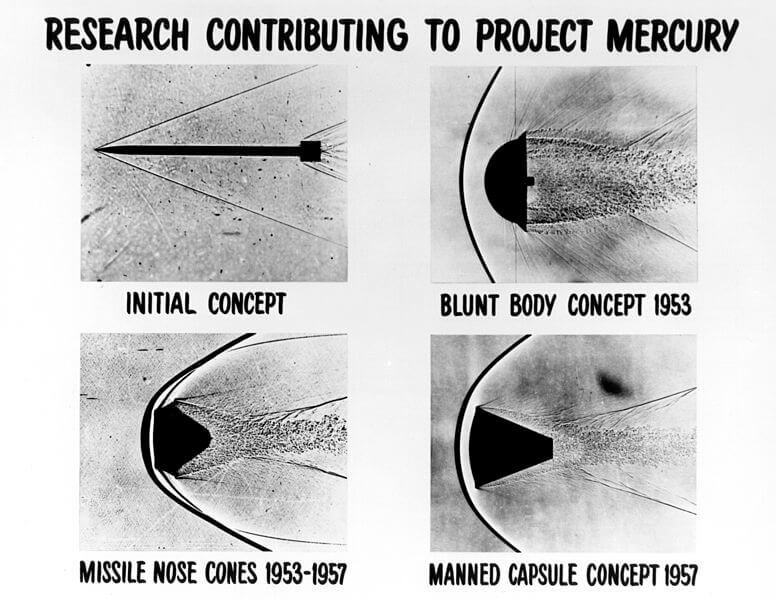
Shadowgraph images of various re-entry vehicles at supersonic speeds in a wind tunnel. The shockwaves and other air density variations cast shadows which are captured by the camera.
When an object travels at supersonic or hypersonic speed, it travels faster than the air molecules can get out of its way (in a sense). This results in a sort of “pile-up” of air molecules on the front of the craft, in which the energy of motion of the craft is transferred to the air molecules as it collides with them. This creates a zone of very high air pressure and usually one or more shock waves on the front side of the craft. A shock wave can be thought of as the leading front of an air molecule pile-up. The temperature, pressure, and density of the air just behind a shockwave are many multiples higher than the air just a few millimeters away on the other side of the shock wave. Imagine a runaway train barreling down the tracks and piling up other train cars and debris on its front bumper. Just a few car lengths ahead of the train everything is normal, but then suddenly it’s just a compressed pile of hot steel.
The kinetic energy of the spacecraft’s motion is transferred to the air molecules through the compression process, converting it into thermal energy and heating up the air. The compressed air is very hot and it transfers this thermal energy back to the skin of the spacecraft through direct contact with the outer surfaces. So there is actually a two-way exchange of energy that heats up the spacecraft.
I hope you find this informative and interesting. Post any questions in the comments and I’ll do my best to answer them. There are no dumb questions!
Published in Science & Technology



Fascinating and impressive, Mark Wilson. You and anonymous are never to visit Iran.
I think I’ve drifted to my libation point…
I (think I) get it now.
I think the illustrations would make more intuitive sense if there were arrows to indicate the outward force created by the objects’ orbits, like so:
It would also be more intuitive if the explanations said what would happen to an object orbiting somewhere other than one of the Lagrange points. For example, an object orbiting somewhere between L3 and L4, but at the same speed as L4, would spiral away from the Sun.
Here’s a question: After billions of years of objects gathering at the Lagrange points, why haven’t they merged to form new planets?Answered my own question. The total mass of the asteroid belt is only 4% of the moon, and the objects that congregate around the Lagrange points are only a small fraction of that already-small total mass.
Another question: Are there asteroids gathering at Jupiter’s L2 Lagrange point? If not, why not?
I noticed that too but was unsure if it was truly a misuse, or just a usage I hadn’t seen before.
It looks like all the available figures on Google show the combination of the gravitational potential and the centrifugal force. If they didn’t include the centrifugal force the whole thing would just be a big deep gravity well sloping toward the sun. But they all omit the Coriolis force from the topography, which is unfortunate because it’s the Coriolis force that causes the asteroids to seemingly slide “uphill”. I’ll see if I can figure out a way to generate a figure that has the swirly Coriolis arrows.
No. The L2 point is unstable in both the static sense and the dynamic sense. Statically the potential field around L2 is shaped like a saddle, so it slopes down and away in two directions. Dynamically, in contrast with the Coriolis forces around L4/5, due to the shape of the field at L2 there are no dynamical interactions that cause an object to remain in the vicinity of L2 in the long term. However, there are ways to place an object in a sort of orbit around L2 that isn’t precisely stable but has a long enough decay time that it can be maintained for a long time with a little fuel.
That must be what was confusing me. The 3-D illustrations make it look like the objects at L4 and L5 are balanced precariously on top of a “gravity hill” (for want of a better term), which would intuitively be the least stable place for them to be.
I think stuff ends up orbiting the gravity hill, if I understand this right, but I could be way off.
That’s where the difficulty lies. The L4 and L5 points are actually energy hills — the force on a perturbed body in the vicinity of L4 or L5 is
repellentrepulsive, not restorative. So they are statically unstable. But the Coriolis and centrifugal forces interact in such a way to create dynamic stability, pushing the body forward, then outward, then backward, then inward, creating a loop.Here’s a paper that covers the dynamic stability of L4 and L5 on pages 11 and 12. For anyone familiar with the theory of linear dynamical systems it might provide insight — the characteristic equation actually shows marginal stability, not true asymptotic stability.
AN ANALYSIS OF STABILITY IN THE RESTRICTED THREE-BODY PROBLEM
If the words in this comment don’t mean anything to you, ignore it! You will be happier for it.